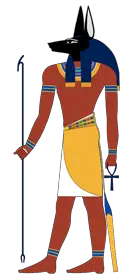The Egyptian God Anubis | God Of Death
Anubis is known as the god of death and is the oldest and most popular of ancient Egyptian deities. The ancient Egyptians revered Anubis highly because they believed he had tremendous power over both their physical and spiritual selves when they died.
References to Anubis are found in texts dating back to the Old Kingdom. His fame lasted until the Middle Kingdom, when his role as God of death was taken over by Osiris and Anubis became Osiris' assistant.
Ancient Egyptians strongly believed in the afterlife, which was an essential aspect of their culture and religion. They considered death a transition to another realm rather than an end.
His Roles included all the following:- God of Mummification
- Protector of tombs and cemeteries
- Guide of souls in the afterlife
- Ruler of the underworld
- Gardian of the Scales of Justice
Anubis The Jackal God
Anubis was either seen as a man with a jackal head or completely in the form of a jackal.
In ancient Egypt, scavengers like jackals ruled the cemeteries. They dug up the freshly buried and tore at their flesh and ate it. Historians believe that this is what prompted the ancients to portray the god of the afterlife as a jackal, to fight fire with fire. New genetic research indicates that the ancient Egyptian jackal is not a jackal at all, but an ancient wolf.
Anubis’ skin is often depicted as black, while jackals are typically brown. The reason is that the color black is a symbol of death, but also a symbol of the Nile’s fertile and black soil.
The Main Role of Anubis
Absolute ruler of the underworld
In very ancient history Anubis was known to be the absolute ruler of the underworld (called Duat). Later theories indicate that this role was taken over by Osiris. Anubis was responsible for overseeing the realm of the dead and ensuring the souls of the deceased were guided safely to their final resting place. As the ruler of the underworld, Anubis was also tasked with maintaining order, protecting the dead from malevolent forces, and ensuring the proper balance between the worlds of the living and the dead.
The Guardian of the Scales:
One of his many roles surrounding the dead included the Guardian of Scales where he dictated the fate of souls. As depicted in the Book of the Dead, Anubis weighs the decedent’s heart against the weight of a feather. The feather represents “Ma’at” or truth. If the scale of justice tipped toward the heart, the dead person would be consumed by Ammit, a female demon the ancient Egyptian people dubbed “devourer of the dead.” If the scale of justice tipped toward the feather, Anubis would lead the decedent to Osiris so he could ascend to a worthy existence in heaven.
The God of embalming and mummification:
Anubis held the important role of overseeing the embalming and mummification of the dead. It was essential to the ancient Egyptian belief in the afterlife. Mummification was intended to preserve the body, allowing the soul, or "ka", to recognize and reunite with it in the afterlife. Anubis was believed to oversee and guide the embalmers during the mummification process. Anubis' role as the god of mummification solidified his importance in the spiritual journey of the deceased.
Several rituals were performed to honor Anubis during the mummification process. One such ritual was the "Opening of the Mouth" ceremony, which involved a priest wearing an Anubis mask and touching the mouth of the mummy or statue with special tools. This ritual was believed to restore the deceased's ability to speak, breathe, eat, and drink in the afterlife. Offerings of food, drink, and other necessities were presented to Anubis, seeking his favor and protection throughout the mummification process and the journey to the afterlife.
The daughter of Anubis (Kebechet), is frequently seen as his assistant in the mummification process of the dead. Ancient Egyptians believed that Anubis sniffed the bodies of the dead, so they preserved them with sweet smelling herbs and plants.
Protector of Tombs:
As the Egyptian god responsible for protecting the dead, many prayers to Anubis were carved into their tombs and offerings were made to him to ensure the safety of the deceased's remains. Anubis his role as protector of the deathextended to both the physical protection of the tombs from grave robbers and the spirutual protection of the death from malovent forces Anubis held this role until Osiris gained popularity and took it over.
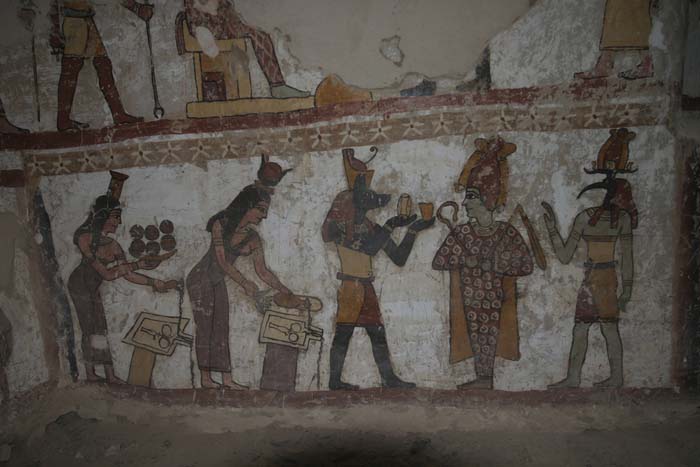
© isawnyu - Paintings from the tomb of Petosiris at Muzawaka (XI)
Scepter and ankh
In ancient Egyptian art, Anubis is often depicted holding specific items that symbolize his roles and responsibilities. The most common objects held by Anubis are the "was" scepter and the "ankh."
The "was" scepter (𓏭) is a long staff with a forked base and a stylized animal head at the top, typically that of a canine. This powerful symbol represents dominion, power, and authority, signifying Anubis' status as a guardian and protector of the dead. However, the "was" scepter is not exclusive to Anubis, as it can also be seen in the hands of other Egyptian gods and pharaohs.
The "ankh" (☥) is a well-known ancient Egyptian symbol that resembles a cross with a loop at the top. It represents the concept of eternal life and is often called the "key of life" or the "key of the Nile." When Anubis holds the ankh, it symbolizes his role in guiding the souls of the deceased to eternal life in the afterlife.
Anubis and Osiris
The mythology of the story varies, but according to legend:
- Osiris' brother (Seth), killed Osiris by luring him into a fancy coffin, sealing it shut, and pushing it into the Nile.
- Osiris' wife and sister (Isis), retrieved Osiris’ body on the Phoenician coastline, but an angry Seth chopped up Osiris’ body and scattered it throughout Egypt.
- Anubis, Isis and Nephthys, set about to find the pieces and were successful (except for Osiris’ phallus).
- Another Egyptian God called Thoth, helped restore the body and Anubis wrapped Osiris in linen, the action of which bestowed on him the title, “He Who is in the Place of Embalming”.
Anubis' role shifted from being the primary god of the dead to a subordinate position to Osiris. Anubis became the god of mummification and guardian of the tombs, while Osiris assumed the role of the ruler of the underworld and judge of the dead.
Despite the shift in their roles, Anubis and Osiris maintained a cooperative and complementary relationship in the afterlif.
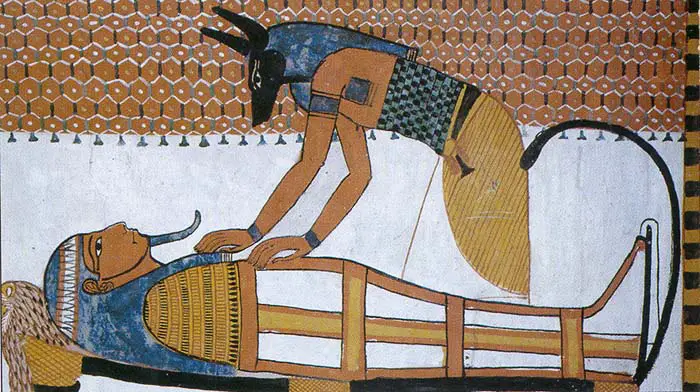
© Asaf Braverman - Anubis Reconstructing Osiris (1350 BC, Tomb of Ramses 1, Egypt)
Anubis Family
Parents
Several versions exist of how Anubis came into being:
- Son of Nephthys and Osiris: the most popular version is that Anubis is the son of Nephthys and Osiris. As the Goddess of Darkness, Nephthys would naturally be mother to a god who oversaw the embalming process and also guided souls into the afterlife.
- Son of Nephthys and Seth: it is also speculated that Seth is Anubis’ father. In this version, it is believed that Nephthys disguised herself as Osiris’ beautiful sister, Isis, to beget a half brother for Horus. As Seth is the God of darkness, storms and destruction, it is easy to see how Anubis could be his son.
- Son of Nephtys and Ra: in early mythology texts, Ra (the sun God), was depicted as being Anubis’ father, while his mother was speculated as being either Hesat the cow goddess, Bastet the cat-headed warfare goddess, or Nephthys.
Wife
Anubis' wife name is Anput (or Input), a lesser-known goddess in the Egyptian pantheon. Like her husband, she is associated with the afterlife, mummification, and the protection of the dead. Anput is usually depicted as a woman with a jackal or a jackal-headed human, similar to Anubis' form. Her iconography is less prevalent in ancient Egyptian art and monuments than Anubis, but she is occasionally mentioned in texts and depicted in various artifacts.
Daughter
Anubis and Anput are believed to have a daughter, Kebechet (or Qebehsenuef), who is also associated with the afterlife. Kebechet is typically represented as a snake or a snake-headed woman and is considered the goddess of purification, providing refreshing, purifying waters to the souls of the deceased during their journey to the afterlife. Her role complements that of her parents, further emphasizing the interconnectedness of the ancient Egyptian gods and their various functions in guiding and protecting the dead.
Anubis' family relationships reflect the interconnected nature of ancient Egyptian gods, with each member playing a complementary role in the realm of the afterlife. As a family, Anubis, Anput, and Kebechet work together to guide, protect, and purify the deceased, ensuring their safe passage to the afterlife and ultimate reunification with their eternal body.
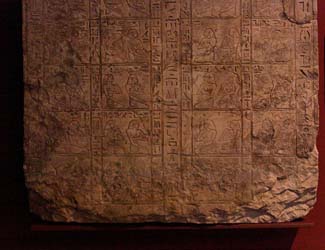
© NeferTiyi - Stèle de Nes-kai-chouti
A Shrine for Anubis
Anubis was worshiped all over Egypt, and his cult center was in Cynopolis, located in the 17th nome (province) of Upper Egypt. Translated, Cynopolis is Greek for “city of the dog,” which fits well because of the close relation between jackals and dogs, and the fact that some scholars believe Anubis was indeed an ancient wolf.
A shrine for Anubis was discovered in King Tut’s tomb in 1922. Made of wood, plaster, lacquer and gold leaf, the statue depicts Anubis in animal form in a recumbent position exactly how he is in his hieroglyph. As the sledge it rested on would indicate, the shrine was probably used in the funeral procession of the great Pharaoh, and was oriented to the west to help guide the Pharaoh into the afterlife (which the ancient Egyptians believed was in the direction of the setting sun).
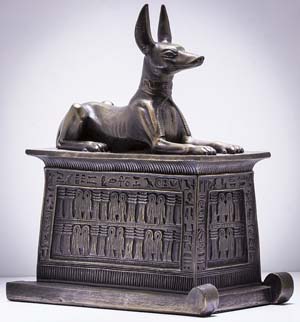
© Tony Cash - Anubis
Anubis in Art
Aside from the Anubis statue discovered in King Tut’s tomb, his representation can be found frequently in ancient Egyptian art. In the Valley of the Kings, an image of Anubis in his role as “Jackal Ruler of the Bows” was often used to seal tombs. The nine bows represented all the enemies of Egypt, and it was believed that Anubis had defeated every one of them. Anubis masks and statuettes dating back to early to late Ptolemaic period (332-30 BC) exist in museums today.
In tomb paintings and murals, Anubis is often shown accompanying the deceased or presiding over the "Weighing of the Heart" ceremony, showcasing his importance in the soul's journey through the underworld. Additionally, funerary texts and inscriptions frequently invoke Anubis' name for protection and guidance, further highlighting his significance in ancient Egyptian religious beliefs and practices.
Statues of Anubis, often in the form of a jackal or a jackal-headed human, were placed in and around tombs and mortuary temples to serve as guardians against potential physical and spiritual threats. The presence of Anubis was believed to deter grave robbers and protect the tomb from malevolent forces.
Anubis in Modern Culture
Anubis continues to hold a place in popular culture, with his image and mythology appearing in various forms of media, including literature, film, television, and video games. His jackal-headed form has become an iconic symbol of ancient Egyptian mythology, often featured in contemporary art and fashion. Anubis has also been a popular subject in fantasy and sci-fi genres, often portrayed as a powerful and mysterious deity with various supernatural abilities. Despite his ancient origins, Anubis' image and symbolism continue to capture the imagination of modern audiences, serving as a reminder of the enduring legacy of ancient Egyptian culture.
Anubis Facts
- Anubis was the god of the dead and the underworld until the Middle Kingdom, when this role was taken over by Osiris.
- He is one of the oldest gods, references in text go back as far as the Old Kingdom.
- Anubis is the inventor and god of embalming and mummification.
- He guided the death through the underworld (called Duat).
- Anubis was the Guardian of the Scales, used to weigh the hearts of dead souls.
- His high level of anatomical knowledge due to embalming made him the patron of anesthesiology.
- A crouching statue of Anubis took a central place in Tutankhamun's tomb.
- Priests who performed the embalming of dead corpses wore a jackal mask.
- Greek mythology blends Hermes with Anubis to result in the god Hermanubis.

